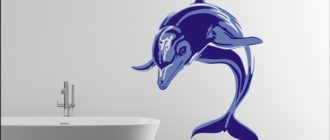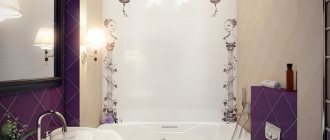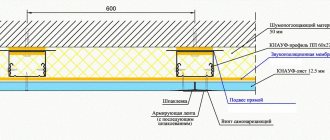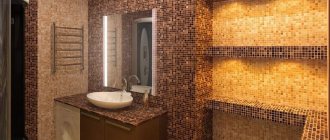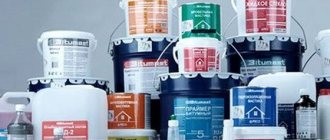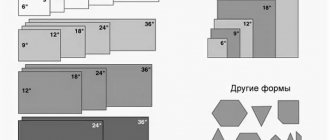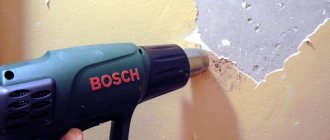Tile is the most popular material when decorating a bathroom. It is used both as wall cladding and in flooring design. Many owners prefer to use an alternative to ceramic tiles in the bathroom. As a suitable economical option, you can use several suitable materials at once.
The familiar tiles are far from the only material that can be used to decorate a bathroom.
Types of plastic PVC panels
The panel is the optimal alternative to tiles in the bathroom. This material helps to stylishly decorate a bathroom at minimal cost. Plastic panels are of high quality and have a wide variety of textures and styles. A wide range helps you choose the cladding for every design and style.
Plastic panels are not afraid of water and are easy to clean
PVC material has several varieties. The product is divided into 2 categories: according to its purpose and size range.
Purpose:
- wall ones are highly resistant to damage;
- ceiling ones are large in size and have a thin wall.
Size:
- Plastic lining is used for external and internal placement. The material is divided into 2 subcategories. The European one has a wide lock, the Polka one has narrow elements for fastening.
- The PVC panel is distinguished by the absence of a seam in the assembled version. The outer part of the elements is coated with varnish or paint to preserve the design and attractive appearance.
- Sheet panel is the most popular and in demand material. Features a large size.
It is easy to hide uneven walls and utility lines under PVC panels
Finishing with PVC panels is a budget solution that allows you to profitably save money
Properties of ceramic tiles
Ceramic tiles are considered a classic finishing material
Before finishing a bathtub in addition to tiles, you need to know its advantages and disadvantages in order to select a material that is not inferior to it in its characteristics.
Ceramic tiles are a classic finishing material that has excellent moisture-repellent properties, durability, antibacterial properties and ease of care. In addition, the tiles differ in size, shape, color and texture, which allows you to choose them for almost any type of renovation. For designers, this is a storehouse of inspiration, because ceramic tiles can be combined with almost any finishing materials and are suitable for finishing walls and floors.
Although ceramic tiles have a bunch of positive properties, there are several negative qualities, namely:
- The tile is very fragile and, when hit by a heavy and hard object, easily splits;
- Complex and painstaking preparation of the surface for laying tiles. The surface must be perfectly flat;
- A complex installation process that requires special skills and can become an impossible task if repaired on your own.
So, what to decorate the bathroom with besides tiles? What materials and finishing methods are suitable for a bathroom?
Application of plastic panels
Plastic panels can have different widths and textures
For wall decoration, the best material would be plastic panels. This material is simple and durable, making it easy to finish the surface in a short period of time.
Due to the fact that manufacturers offer different sizes of plastic panels for the bathroom, they can vary from 10 centimeters to 30 or more, and models are also available with and without a seam. There are also different sizes of PVC panels for the bathroom in length, which can vary from 2 to 6 meters, it depends on the transport supplying the material. All this allows you to create the desired design without having any special knowledge.
In addition, the panels are produced in various colors and textures, which determines the cost of finishing. They can imitate the surfaces of various types of trees, the surfaces of stones, bricks, etc. PVC panels can also be made in glossy or matte form. All this diversity and low cost of PVC panels for the bathroom allows you to implement any design solution and at the same time spend a relatively small amount of money.
How to make a ceiling in a bathroom? Recommendations for choosing material and installation technology
Advice! For walls and ceilings, the width of the plastic panels is selected differently. Wide seamless panels are most suitable for walls, and narrow ones for ceilings.
An example of wall cladding with PVC panels
Inexpensive plastic panels are very simple to use; they are easy to clean using ordinary household chemicals, as they are not afraid of moisture and sudden temperature changes. But it is prohibited to use aggressive detergents and abrasives, because the soft finishing material will quickly lose its appearance.
Another undoubted advantage of installing panels instead of tiles is the ease of installation and the unpretentiousness of the material to the base surface. That is, to install PVC panels, it is enough to install a wooden or metal frame without leveling the surface or repairing chipped cracks. Of course, with large defects in the walls, basic alignment will have to be done.
Among the disadvantages of plastic panels are the following:
- Cheap bathroom panels are resistant to open fire and easily ignite. Panels made from high-quality and more expensive plastic do not burn, but when set on fire, they go out on their own;
- Cheap PVC panels have an unpleasant odor, and it often lasts for a long time. Therefore, it is better to purchase more expensive but safe materials. There is no foreign odor or it disappears after a few days;
- Due to its properties, plastic is very fragile and after an impact a hole can form in it. Therefore, the material must be handled very carefully, do not lean any objects against it or lean on it;
- All types of plastic panels for the bathroom are an order of magnitude inferior in appearance to other more noble finishing materials. Often such panels are used for public spaces.
If during renovation the question arises: “Which panels are best for the bathroom?”, then the answer is very simple, the better quality (most often they are more expensive), the better. Therefore, you need to choose PVC panels only from trusted manufacturers. And avoid cheap ones, because they can be harmful to health.
Painting walls and floors
Painting walls with water-based paint
Paint, as an alternative to tiles in the bathroom, is a very simple and very economical finishing option. Thanks to modern high-quality enamels, the bathroom will shine for a long time, and even the most inexperienced renovator can easily update the tarnished coating.
Currently, there are high-tech latex enamels that have excellent water-repellent properties and are not subject to temperature changes, which is ideal for the bathroom. And the smooth, glossy surface after painting with water-based paints can be easily washed with any detergents and a soft sponge; it is not afraid of dirt and grease deposits.
Note: Just like cheap plastic panels, painting is a very economical way to repair, provided that the base coat is in excellent condition. Otherwise, high-quality leveling of walls or floors and painting may cost more than tiling.
Also, thanks to the rich color palette and the ability to create different shades of colors, coloring makes it possible to realize any design fantasies.
The main disadvantage of painting is the requirements for the condition of the surface that will be finished, especially in the corners. They must be perfectly shaped, otherwise all imperfections will be visible after painting, which will ruin the entire design of the room.
Bathroom renovation with panels. Advantages and disadvantages of the material and recommendations for selection
Agglomerate and poured floor
Self-leveling floor with 3D effect
Another option for finishing walls and floors is the use of agglomerate and poured flooring. These are completely new finishing methods that have begun to gain popularity among professional builders.
Agglomerate is perfect for wall decoration, because it has increased strength and density, it is not afraid of moisture and sudden temperature changes. This material is applied using cement, which serves as a binder. And to create a seamless surface, the agglomerate is applied with preheating to 650 degrees, which will allow it to be given any shape and create curved surfaces. At the same time, the rich palette of colors and glossy surface look like ceramic tiles.
The poured floor also has a glossy finish and an ideal shape, since the pouring method is used to apply it. This coating is very strong and durable, but cold. Therefore, such flooring should be used with underfloor heating systems. Among the disadvantages of such a coating is the need to pre-level the surface before pouring, and the final result will depend on the quality of the operation performed.
As an alternative to ceramic tiles in the bathroom, agglomerate and poured flooring are excellent materials, but they have one major drawback in common, namely the extremely high price.
Other alternative ways to decorate a bathroom
Wall cladding with marble
In addition to the above-described methods of finishing a bathroom, other materials can be used instead of tiles, but often they are rarely used due to their high cost or fragility.
- Wallpapering is a very simple, but short-lived way of finishing a surface. Even if you use high-quality waterproof acrylic, vinyl or fiberglass wallpaper, their service life is unlikely to exceed 5 years or more. Since constant moisture and sudden temperature changes will certainly damage the coating. In addition, this finishing method requires a perfectly leveled surface.
- An excellent alternative to tiles in the bathroom is finishing with natural marble. This finishing method is suitable for both walls and floors. Marble stone can be of various shades from almost white to black, this indicator depends on the place of extraction of the material. By its structure, marble stone is very porous and strongly attracts dirt, which is also difficult to remove. In addition to being difficult to maintain, marble is an expensive finishing material, and not everyone can afford it.
- Another rarely used material is glass instead of tiles in the bathroom, or more precisely, stained glass and mosaics. This type of finishing material is perfect for decorating walls, but, unfortunately, it cannot be used for every design. In addition, stained glass windows and mosaics are very difficult to perform independently and require the “hand of a master,” which, coupled with the high cost of materials and finishing, makes this type of finishing very expensive.
- If tiles or panels are not suitable for the bathroom, you can use wood. This material is environmentally friendly and durable, subject to proper processing and care. The material is also tactilely pleasant and suitable for finishing both walls and floors. At the same time, it does not require leveling the surface to an ideal state. But unfortunately, this type of finishing is very expensive and is not suitable for every room design.
Decorative plaster or textured paint
Plaster in the bathroom instead of tiles is one of the non-standard, but stylish solutions. Using this method, you can not only replace the usual tiles, but also decorate the bathroom according to an individual sketch.
The properties of decorative plaster allow you to create original textures on the surface of the walls
The main advantage of plaster is the complete elimination of the possibility of the development of fungus and mold. The material actively absorbs moisture, which helps reduce humidity in the room. Despite long-term use, the surface retains its color saturation and does not crack or crumble. In addition, the material does not contain toxic substances.
Decorative concrete-look plaster in a minimalist bathroom interior
Using decorative plaster you can create an original and unusual relief. This finish would be a smart option for finishing a bathroom in a Scandinavian or loft style.
The main criterion when purchasing is the choice of waterproof material.
Before plastering the walls in the bathroom, you should take into account the characteristics of the surface itself and the high level of humidity. Compositions based on cement or gypsum are suitable for placement in the bathroom.
There is decorative plaster on top of the wall and plastic lining underneath - a popular solution for an ethno-style bathroom, Provence or country
What should NOT be on the walls in the bathroom
But it’s high time to stop using plastic lining in the bathroom: it’s high time to delete this short-lived, unhealthy and simply ugly material from the list of bathroom linings. And, we bet, the last time you saw it was in the bathroom of an apartment that was renovated in the 1990s. Compared to the same phone models, the plastic in the bathroom is not even a phone, but a useless pager that has disappeared forever.
Agglomerate and self-leveling floor
Agglomerate is often called artificial stone. This material is similar in appearance to ordinary tiles. An important difference is the high wear resistance. The agglomerate is less susceptible to damage and is durable. The elastic structure helps in implementing unusual interior solutions. This type of coating is suitable for decorating round or oval rooms.
The agglomerate can be used to cover floors, walls and other surfaces exposed to moisture.
Self-leveling flooring is considered a suitable option when decorating a bathroom. The material is highly resistant to damage and is reliably protected from scratches and cracks. If dirt, stains or dust appear, the floor surface can be easily cleaned using specialized products. If necessary, a heated floor system can be installed under the main covering.
The surface of the self-leveling floor can be plain or with a pattern
Self-leveling floors with a 3D effect look very impressive
The advantages of self-leveling floors also include solidity. The material is arranged in a full array, which eliminates the possibility of seams or joints.
Self-leveling floor with a spectacular stylization of wet sand
Options
You can replace tiles in a shower in a number of new and not so new ways. Each of them has its own advantages and disadvantages both in relation to ceramic products and in relation to each other. It is worth noting that today there are no ideal materials. Therefore, certain weaknesses should be tolerated, minimized, or skillfully avoided. Alternative:
- Dye.
- Tree.
- Plastic panels.
- Mirror or glass tiles.
- Waterproof or liquid wallpaper.
- Fake diamond.
- Mosaic.
Related article: How to make a heated floor in a private house on a wooden floor
Bathroom
Of course, some materials are very controversial, while others can be used under certain conditions, for example, wood. After all, ordinary rocks are absolutely not suitable for replacing tiles. Why is it recommended to use waterproof ones - beech or stained oak. However, this option will not be affordable for many consumers, and it is more suitable for the floor than for the wall.
Waterproof or liquid wallpaper
An alternative option in a bathroom without tiles on the walls would be wallpaper. Such wallpapers are treated with a special water-repellent impregnation, which makes them suitable for placement in bathrooms. In case of contamination, the surface can be easily cleaned using specialized chemicals. If necessary, such wallpaper can be changed to another option with brighter colors or patterns with minimal effort.
Waterproof wallpaper with floral print in a classic-style bathroom
The material has a budget price and a wide range. A vinyl or acrylic option is suitable for placement in the bathroom. Many users use liquid wallpaper, which is highly environmentally friendly.
Liquid wallpaper differs favorably from regular wallpaper in that it allows you to quickly repair damage to certain areas of the wall.
There is a special marking on the packaging of waterproof wallpaper, which helps facilitate the process of finding the right material.
Paintable glass wallpaper is best suited for rooms with high humidity.
Coloring
Using paint is the most economical and simplified way to change the interior of a bathroom. This decoration method is a suitable option for rooms decorated in Scandinavian, loft or Provence style.
Walls covered with matte paint go well with classic or rustic styles.
Before painting the walls, the surface must be prepared for work. The plane is carefully leveled, treated with several layers of primer, and then painted. This will help avoid the appearance of streaks, smudges and unevenness. You can apply the desired pattern on top of the base layer, which will give the room a bright and stylish appearance. When applying painting, special stencils will be useful. If necessary, the design can be easily changed with a new color.
Paint allows you to create an original and unique bathroom design
One of the disadvantages of coloring is the need for regular care. The walls must be constantly cleaned of accumulated dirt and dust. A specialized chemical composition is suitable as a cleaning agent.
It is recommended to use latex-based paint as a consumable, which is resistant to liquids and dirt.
Bright bathroom interior created by painting surfaces in contrasting colors
Technologies for leveling walls with plaster
A smooth surface shows the quality of the plaster. Coating of walls and ceilings is carried out after instrumental control.
- Dismantling structures that interfere with work. Niches, window sills, window frames. Removing the door and decorative elements. Equipment removal: toilet, bidet, sewer pipes.
- Cleaning places from the old layer of cladding, removing protrusions in the walls and ceiling. All available tools are used: scrapers, grinders, grinders, drills, hammer drills.
- Cracks, open cracks, potholes, holes in the wall and ceiling are repaired. The affected areas are thoroughly cleaned of dust and covered with cement mortars and alabaster.
- Removes stains and greasy surfaces where a layer of plaster does not adhere. Areas with fungus and mold are treated with copper sulfate, detergent compounds, washed with water, and dried. Places are checked for the absence of residual grease, mold, and mildew.
- Primers are applied and walls and ceilings are protected.
- Beacons are installed and attached to the surface. The pitch of the beacons is adjusted by level.
- Spraying of the ceiling walls is done, 7-12 mm without leveling or smoothing.
- Spray dries and hardens in no more than 3 hours. The base composition is applied after 3 hours.
- Preparation is done in continuous layers on top of sprinkling.
- Aligned by rule. After hardening, the beacons are removed and the holes are leveled.
- The coating is applied evenly in a layer of 3 mm.
- The plastered surface is given time to harden. Grind with a special grater.
- Leave for 12-36 hours.
- They are making decorations.
A smooth surface shows the quality of the plaster.
Stone for the bathroom: all the pros and cons
Stone is used not only for making bathtubs, sinks and other furniture and household items. Many users use this material when tiling the bathroom in the house. This design method has certain positive and negative qualities that should be taken into account when choosing.
The stone is perfect for highlighting an accent wall in a bathroom interior.
Key Features:
- solidity (complete absence of seams);
- the likelihood of the development of mold and fungi is excluded, despite high humidity;
- resistance to damage;
- the ability to design both some areas and the entire room;
- high sound insulation rates;
- long service life;
- a wide range of.
Flaws:
- heavy damage repair;
- when carrying out cleaning, it is advisable to use specialized compounds, which are expensive;
- sensitivity to temperature changes;
- high pricing policy.
Natural stone looks like an expensive and presentable material
The use of stone when installing walls and floors is the best option for a Scandinavian, classic style.
Lining and wood
Wood finishes are not the best choice for bathroom design. When selecting, it is recommended to pay attention to materials with water-repellent impregnation. This will reduce the likelihood of mold, bacteria and fungi developing. Oak or ash would be suitable options. Of the more expensive species, you can pay attention to larch, cedar, and bamboo.
A creative solution in the form of wooden tiles coated with waterproof varnish
You can provide wooden panels with additional protection from moisture yourself. Varnishing the surface will help with this. It promotes the formation of a protective film that will prevent the formation of harmful bacteria and preserve the structure of the material.
A suitable choice would be lining. The structure of such panels is characterized by high rigidity, which eliminates the possibility of deformation or torsion during use. For additional protection, it is recommended to treat the material with an antiseptic before distribution.
Wooden lining is often used to decorate the walls of spacious baths in country houses
In order to avoid the risk of mold or mildew, it is recommended to mount the lining vertically.
Chalet style bathroom interior with wood trim
Artificial stone tiles
Artificial stone tiles are an interesting alternative to tiles in the bathroom, which is especially suitable for those who prefer interior styles such as loft, rustic, chalet or boho.
To make such tiles, different materials are used. These can be ceramic mixtures, lightweight concrete, cement, gypsum. As well as polymer-cement compositions with the presence of epoxy or acrylic resins. And it is precisely based on the composition that tiles can be made to suit different surfaces - old brick, unpolished natural stone, processed concrete, etc.
The material is very interesting, and its wide range of colors and different textures make it possible to implement the most unusual design ideas.
Among the advantages of artificial stone tiles are:
- affordability;
- wide choice of color and texture;
- steam resistance;
- durability;
- fast restoration;
- safety;
- ease of installation.
There are not many disadvantages to this material; the main thing is to choose high-quality products, otherwise the tiles will simply crumble from exposure to steam and water. Also, the material should not be used for finishing areas around the bathtub and sinks. The thing is that limescale will clog into the recesses, which are very difficult to clean.
Advice! The artificial stone surface should be coated with a protective composition in the form of acrylic enamel, latex paint or stone varnish. This will give the material additional protection from strong exposure to moisture.

